The CSS Solved General Science & Ability (GSA) Past Paper 2012 is Solved by Pakistan’s top GSA Coach, Miss Iqra Ali. They are the only coaches available in Pakistan who have solved the last 20 years GSA solved papers to help aspirants know how to attempt the paper to score above 80. And they have guided thousands of CSS and PMS aspirants. Both coaches have been known for their teaching methodology and imparting concepts to their students, who scored the highest marks in this subject. At the special request of CSSPrepForum, both coaches have solved the paper.

PART-II
Question No. 2
Write briefly about two or more major achievements of each of the following two famous Muslim scientists
(A) Abu Abdullah Mohammad Bin Musa Al Khwarizmi
(B) Abu Ali Al Hassan ibn Al Hassan Al Haytham
Question breakdown
In this question, the examiner has asked you to explain the achievements of two of the most eminent Muslim scientists – Abu Abdullah Mohammad Bin Musa Al Khwarizmi and Abu Ali Al Hassan ibn Al Hassan Al Haytham. However, the header of “Muslim Scientists” has now been omitted from the General Science and Ability Syllabus by FPSC from the year 2016 onwards. Hence, the question is considered outdated, and there is no need to prepare it, therefore, not solved in the paper.
Question No. 3
(A) List four or more physical characteristics of the Earth
Question Breakdown:
In this question, the examiner has asked you to describe the physical characteristics of the earth. So, to answer this, first, write a basic understanding of Earth as a planet in two to three lines. Then, write any of the four physical characteristics of Earth with all possible diagrams. Remember, avoid writing too many points; instead, try to give pictorial representations of the points explained.
Answer
Define Earth:
Earth is the third planet of the solar system that orbits around the Sun and is the only astronomical body known to harbour life. It is the fifth largest planet in terms of size and mass, with its axis of rotation at a constant tilt, resulting in the change of seasons. The physical characteristics of the Earth include
Physical Characteristics of Earth
- Shape
Widely, the earth, unlike the Sun and moon, that is spherical, is an irregularly shaped ellipsoid.
- Size
The diameter of the Earth at the equator is 12,756 km (7,926 miles), and its circumference or distance around the Earth at the equator is 40,075 km (24,901 miles). When compared to the sun, the Earth is about 109 times smaller in diameter. On the other hand, it is about four times the diameter of the Moon
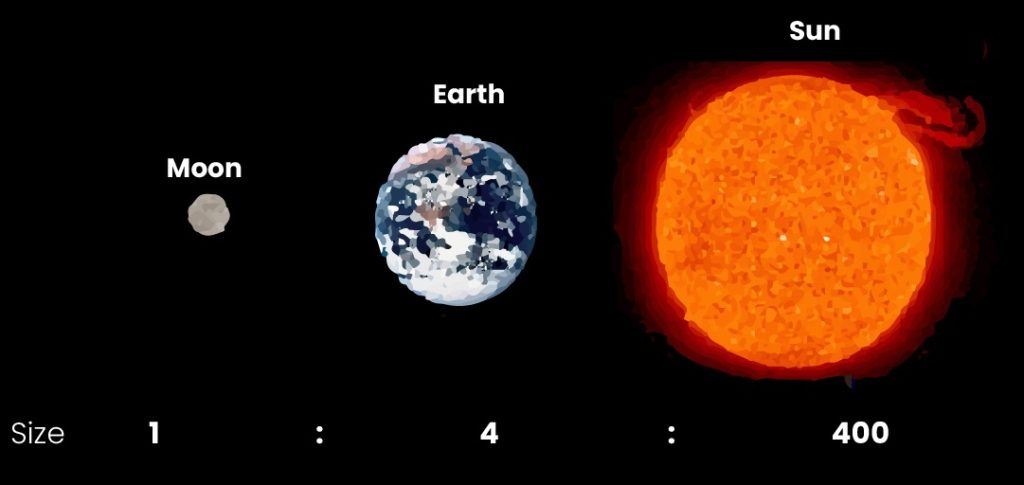
- Composition
The composition of the Earth consists of the solid and liquid portion and the atmosphere or gaseous portion. The percentage composition of the Earth’s solid, liquid and gaseous materials (by mass) is
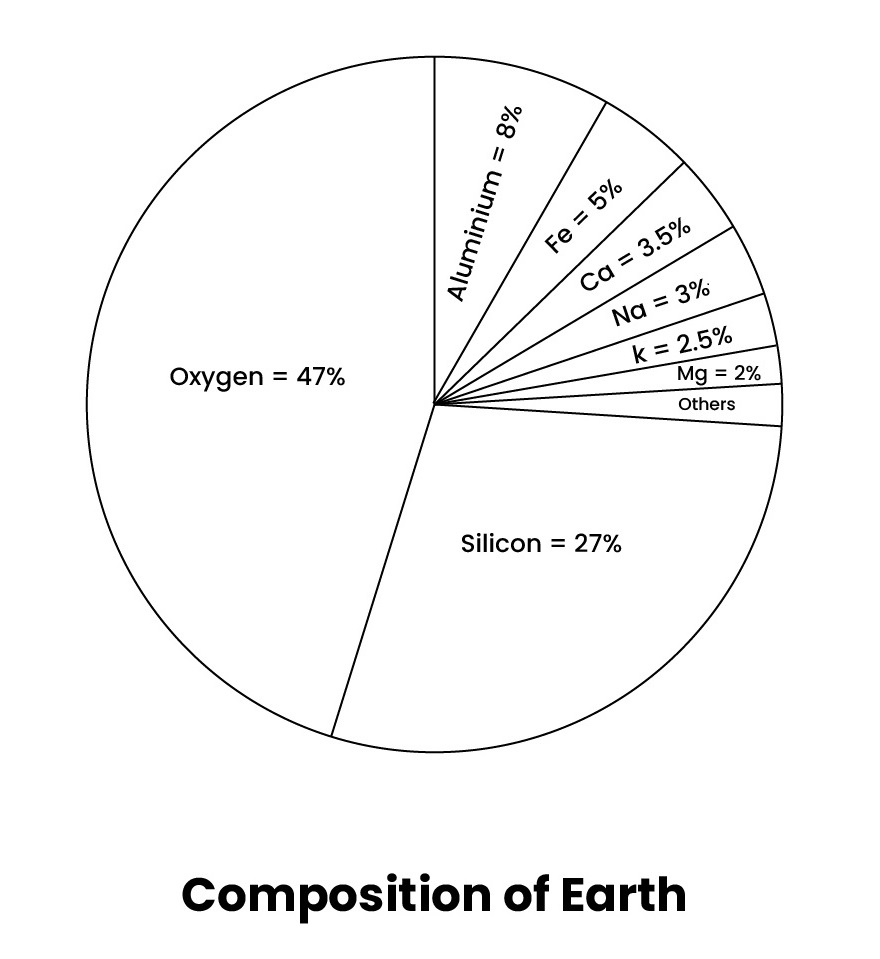
- Force Fields
The Earth has two major force fields: gravity- the force with which the Earth holds down the atmosphere, oceans and everything else- and magnetism -the force that is responsible for the rotation of the Earth.
(B) Briefly explain how Seasons and Ocean Tides are produced on the Earth
Question Breakdown
In this question, the examiner has asked you to describe the process of season formation and the formation of ocean tides. So, first, explain the phenomenon of seasons with a proper diagram. Then, move to part two and explain the process of ocean tides. Also, do not forget to draw a diagram here too.
Answer
Formation of Seasons
Seasons occur due to the spin of the axis. As the Earth’s spin axis is tilted 23.5, it causes the different seasons on the Earth. When the Earth revolves around the Sun, one part of the Earth tilts towards the Sun and the other part away from the Sun. The part that leans towards the Sun gets more sunlight and has summer, whereas the other factor away from the Sun receives less sunlight and has winter. Likewise, when the North Pole tilts towards the Sun, the Northern Hemisphere experiences the summer season while there is a winter season in the Southern Hemisphere. Similarly, when the South Pole tilts towards the Sun, the Southern Hemisphere experiences the summer season, and the Northern Hemisphere experiences the winter season. Again, when the Earth is 90 degrees close and away from the sun, it leads to spring and autumn, respectively. The diagram is clearly describing the seasonal variations on the Earth.
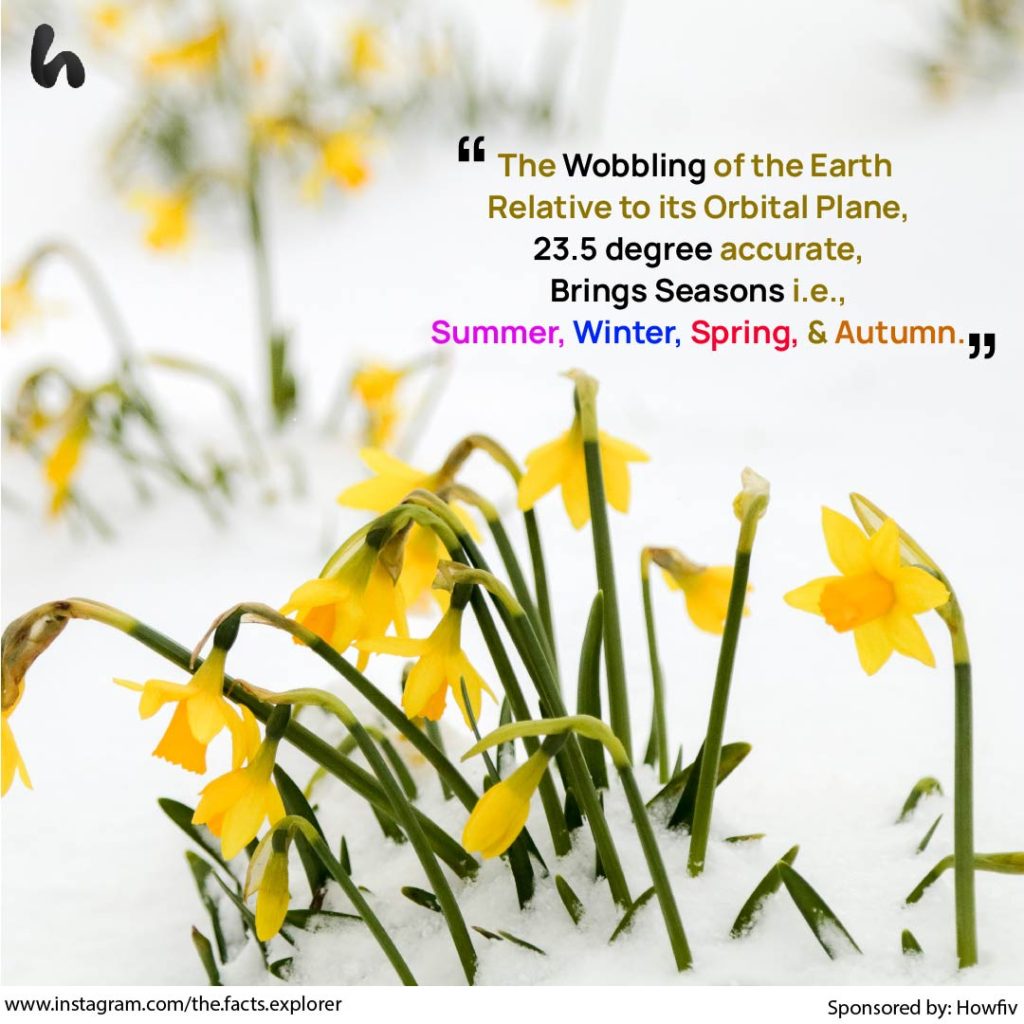
Formation of Ocean Tides
Ocean tides, the long waves that move across the ocean, are generated by a combination of gravitational attraction from the moon and the sun, as well as the centrifugal force generated by the rotation of the Earth. The position of both celestial bodies affects the surface height of the tides as water is gravitationally pulled upwards relative to their positions. Although the moon is smaller than the sun, its nearness to Earth means its gravity has twice the effect on tides. Portions of the ocean are pulled together, creating high-water regions when the moon and sun exert their effects. Due to the constant mass of the oceans on Earth, this effect creates areas where the water levels become much lower.
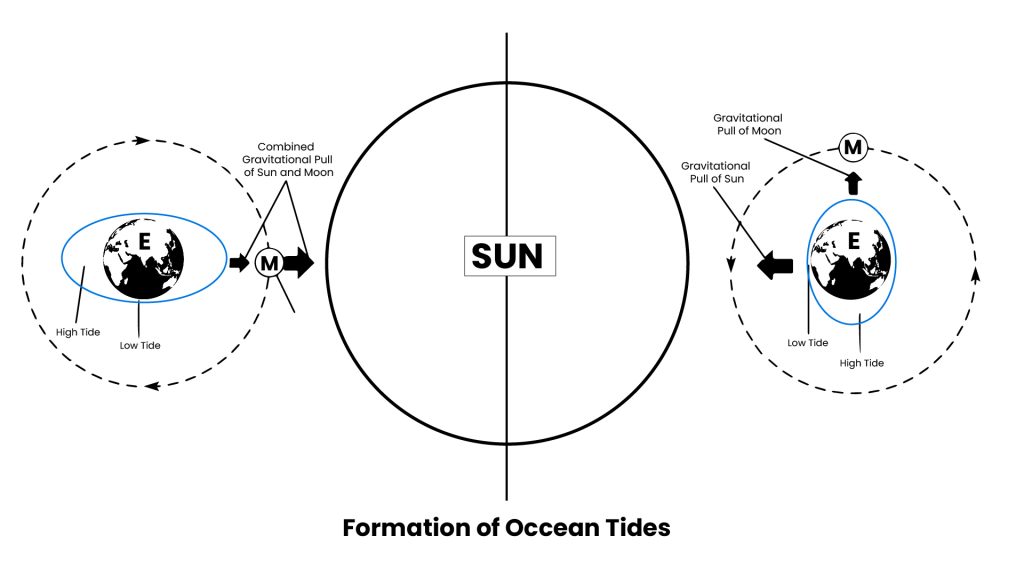

Question No. 4
Question Breakdown:
In both parts of this question, the examiner has asked you to differentiate among multiple jargons. In the first part, the key differences are to be explained of natural disasters: Earthquakes, Volcanic Eruption, Flood, and Tsunami. Make a table with five columns, with one column explaining the characteristics. Likewise, the second part requires the differences of sedimentary and metamorphous rocks. For this, draw three columns. In the end, draw diagrams of all to make your answer appealing and attractive because the only thing that can help you gain maximum marks is presentation with proper pictorial representations.
Answer:
(A) Very briefly explain the difference between Earthquakes, Volcanic eruptions, Floods, and Tsunamis.
| Characteristics | Earthquake | Volcanic Eruption | Flood | Tsunami |
| Definition | An earthquake is defined as a sudden slip on a fault line of the earth’s tectonic plates that results in the trembling of the Earth along with the release of seismic energy. | A volcano is a rupture or opening in the earth’s surface that allows magma (semi-liquid rock), volcanic ash and gases to escape. | An overflowing of a large amount of water beyond its normal confines, especially over what is normally dry land. | A tsunami is defined as a series of huge, uncontrolled sea waves that move forward at a great pace to engulf anything that comes in its direction. |
| Cause | Shaking of tectonic plates | Eruption of magma due to Pressure of gases in rocks | High water levels, heavy rains due to rain or snow melting | Movement of water waves due to some underwater explosions |
| Occurrence | Interior of the crust approximately ≥ 100 meters below the surface | Planetary surface | Near large water bodies- river floodplains and coastal areas | at the floor of the ocean or even beneath it. Mostly across the Pacific Ocean |
| Prediction | Difficult to predict | Can be predicted a few days before | Possible to predict | Difficult to predict |
| Measurement | Richter scale, Seismograph | Volcanic Explosivity Index (VEI) | Radars, Rain gauges | Deep-ocean tsunami detection bouys |
| Precautionary Measures | Varies depending on location | Precautions can be taken | Precautions can be taken | Precautions can be taken, but limited impact |
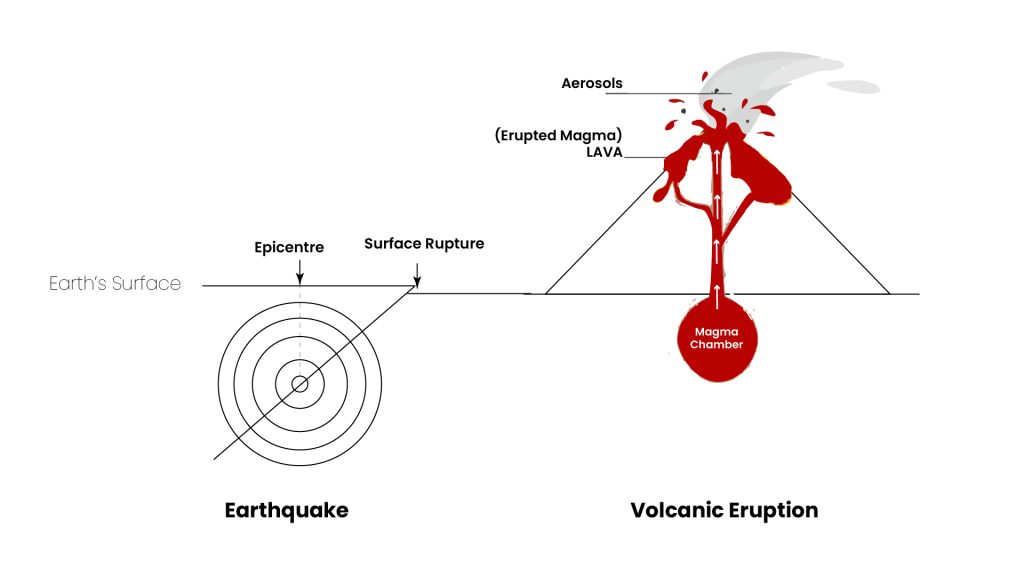
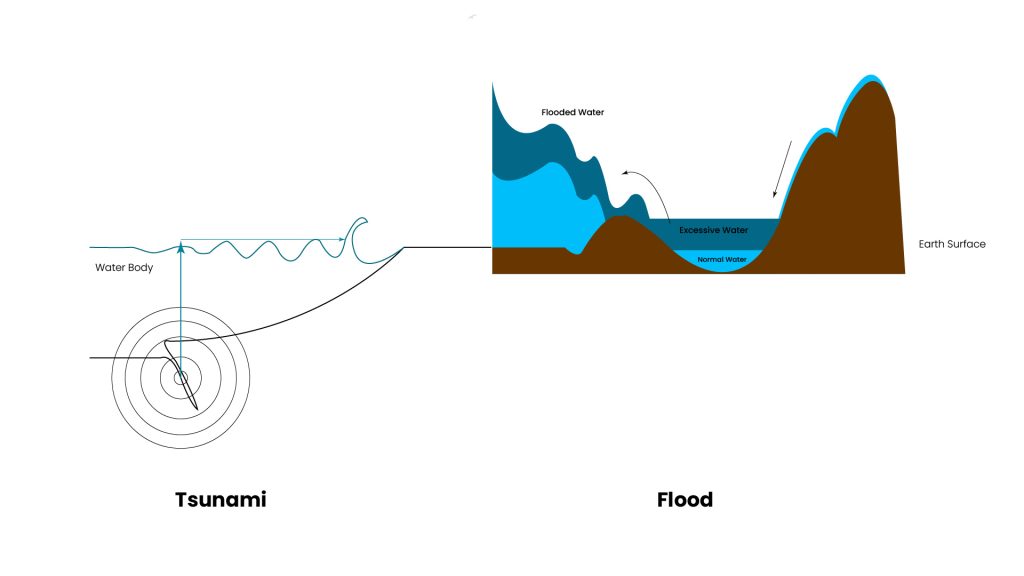
(B) Briefly explain the difference between sedimentary and Metamorphic rocks.
| Characteristics | Sedimentary Rocks | Metamorphic Rocks |
| Formation Process | Formed by consolidation and cementation of sediments deposited by water, air, glaciers, etc. | When heat and pressure change the structure of an existing rock, it forms metamorphic rocks. |
| Color and Weight | Light-colored and lightweight | Dark-colored |
| Grain Texture | Interlocking texture of large grains. | May display interlocking grains but are typically lightweight. |
| Appearance Over Time | Often shiny and can change multiple times into other rock types. | Require extreme heat and pressure for transformation into new rocks. |
| Earth’s Crust Coverage | Covers about 80% of Earth’s crust | Covers about 12% of Earth’s crust |
| Examples | Limestone, Gypsum, Rock Salt | Slate, Quartz, Marble |
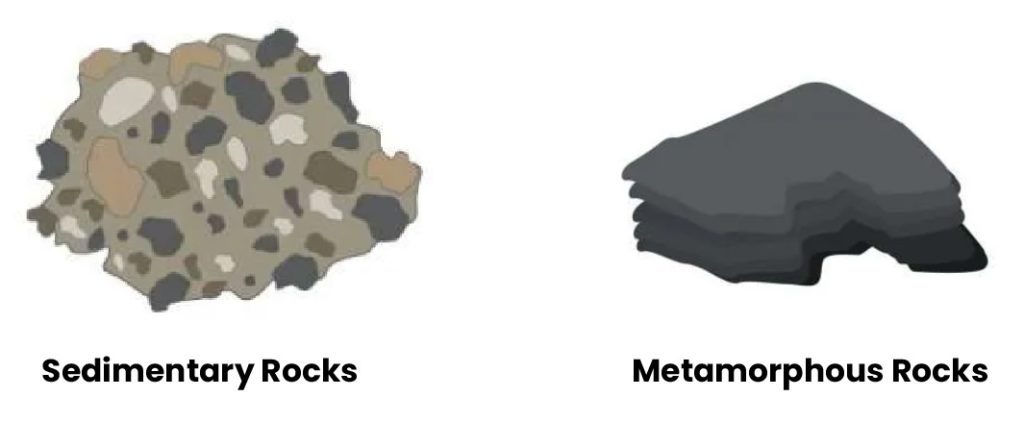
Question No. 5
Question Breakdown:
In both parts of this question, the examiner has asked you to differentiate among multiple jargons. In the first part, the key differences are to be explained of the materials based on their conductivity: Insulators, Conductors, Semiconductors, and Superconductors. Make a table with five columns, with one column explaining the characteristics. Likewise, the second part requires the differences of Laser and Voltaic cells. For this, draw three columns. In the end, draw diagrams of all to make your answer appealing and attractive because the only thing that can help you gain maximum marks is the presentation with proper pictorial representations.
Answer:
(A) Very briefly explain the difference between an Insulator, a Conductor, a Semiconductor, and a Superconductor.
| Charateristics | Insulator | Conductor | Semiconductor | Superconductor |
| Definition | Materials having the least electrical conductivity | Materials with fairly good electrical conductivity, i.e., permit easy flow of charges | Materials that have electrical conductivity less than that of conductors. | Conducting materials having zero electrical resistance or maximum conductivity |
| Forbidden energy gap | Large (>5 eV) | Not exist | Small (1 eV) | 10^-4 eV |
| Conductivity | Very Low (10-3 mho/m) Almost negligible. | High (107 mho/m) | Medium (10-7 to 10-13 mho/m) | Infinite |
| Resistivity | High | Low | Moderate | Zero |
| Flow of current | Almost negligible but only due to free electrons. | Due to the movement of free electrons. | Due to the movement of electrons and holes. | Josephson currents, Critical current, Persistent current |
| Temperature coefficient of resistance | Negative | Positive | Negative | Zero |
| Charge carriers in the conduction band | Completely vacant | Completely filled | Partially filled | Completely filled |
| Charge carriers in the valence band | Completely filled | Almost vacant | Partially filled | Vacant |
| Example | Paper, rubber, glass, plastic etc. | Copper, Aluminum, graphite etc. | Silicon, Germanium, arsenic etc. | Zinc, Aluminum |
| Applications | Used in sports equipment, home appliances etc. | Used in conducting wires, Transformers, etc. | Used in diodes, transistors, opt couplers etc. | Used in generators, transportation, etc. |
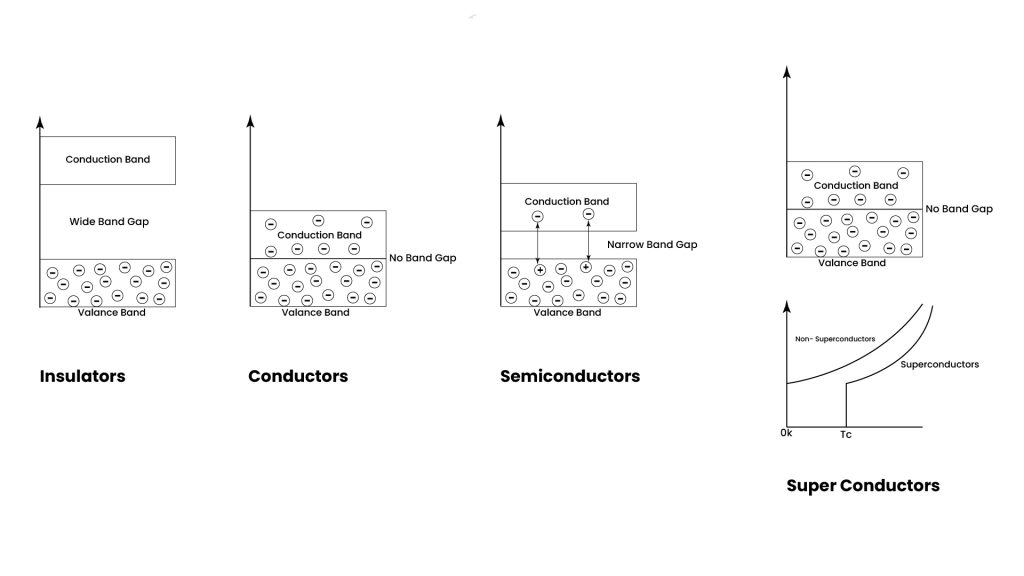
(B) Briefly explain the difference between a Laser and a Photovoltaic Cell.
| Characteristic | Laser | Photovoltaic Cell |
| Definition | A device that emits a highly intense coherent light beam through optical amplification | A device that converts light energy into electricity |
| Components | Consists of three components: a medium, energy source, and optical resonator | Consists of layers of semiconducting material |
| Operation Mechanism | Operates by pumping atoms or molecules into a more energetic state | Operates by creating an electrical field across its layers when exposed to light, causing electricity to flow. |
| Cost | Generally expensive to use. | Tends to reduce the cost of electricity production. |
| Examples | E.g., Fiber laser | E.g., Silicon cell |
Question No. 6
Question Breakdown:
In the first part of this question, the examiner has asked you to differentiate among multiple Drugs: Antibiotics, Antiviral Drugs, Pesticides, and Vaccines. Make a table with five columns, with one column explaining the characteristics. In the end, draw diagrams of all to make your answer appealing and attractive because the only thing that can help you gain maximum marks is the presentation with proper pictorial representations. In the next part, the examiner demands the name of NMR vaccines w.r.t. diseases on which they work, along with two other vaccines.
Answer:
(A) Briefly explain the difference between an Antibiotic, an Antiviral Drug, a Pesticide, and a Vaccine.
| Characteristic | Antibiotic | Antiviral Drug | Pesticide | Vaccine |
| Definition | Antibiotics are small molecules that are used for treating infections caused by organisms such as bacteria, fungi and protozoa. | Medications that help your body fight against certain diseases causing viruses. | Any substance that is intended for preventing, repelling, destroying, or mitigating any pest. | Dead or weakened organisms or substances that are used to provide immunity to a particular infection or disease. |
| Target Microorganisms | Bacteria | Viruses | Various pests (e.g., insects, fungi, weeds) | Viruses or bacteria |
| Purpose | Kills or inhibits the growth of bacteria. | Inhibits the replication of viruses. | Kills or controls pests that damage crops or cause disease. | Stimulates the immune system to provide protection against specific diseases. |
| Medical Use | Used to treat bacterial infections in humans and animals. | Used to treat viral infections in humans. | Not used for medical treatment but for agricultural purposes. | Used for disease prevention in humans and animals. |
| Mode of Action | Interferes with bacterial cell wall synthesis or other essential processes. | Targets viral replication processes. | Disrupts the nervous system, metabolism, or other essential functions in pests. | Triggers an immune response to produce antibodies and memory cells. |
| Resistance Concerns | Bacterial resistance can develop over time. | Viral resistance can develop, but less common than bacterial resistance. | Pests may develop resistance over time. | No resistance development, but effectiveness may decrease with time. |
| Examples | Penicillin, Amoxicillin | Oseltamivir (Tamiflu), Acyclovir | Insecticides, Herbicides | MMR vaccine, Influenza vaccine |
(B) List any two of the three things that the MMR vaccine protects against, List any two other vaccines given to the children.
Following diseases can be cured by the MMR Vaccine
- Mumps
| Cause | Symptom |
| Virus | Fever, Headache |
- Rubella
| Cause | Symptom |
| Virus | A mild illness, sore throat, etc. |
Vaccines that are given to children
| Name | Purpose | |
| 1 | HPV Vaccine | to protect from HPV infection and cancer. |
| 2 | Influenza | to protect from the flue. |
Question No. 7
Question Breakdown:
This question deals with the explanations of two main phenomena: Photosynthsis in the first part and Nitrogen Cycle in the second. Thus, to deal this question, first define the terms, and then explain the procedure and in the end diagrams. Do the same with both parts. Remember, writing too much can never help you explain the best marks in your GSA paper, but your presentation does.
Answer:
(A) Briefly explain how Photosynthesis works.
Define Photosynthesis:
Photosynthesis is a process through which green plants and certain other organisms transform Co2 and water with the help of light energy into energy-rich organic compounds and O2.
Process of Photosynthesis:
In chemical terms, photosynthesis is an oxidation-reduction process, engined by sunlight mainly. On the one hand, water (H2O) is oxidized to form oxygen gas (O2), electrons, and hydrogen ions (H+). From here, the removed hydrogen ions and electrons, ultimately, are transferred to carbon dioxide (CO2) to reduce it to the organic products. Moreover, remaining ions and electrons are used to reduce sulfate and nitrates to sulfhydryl and amino groups in amino acids. In most green cells, carbohydrates are the major products of photosynthesis. Minimum six molecules of CO2 and six molecules of water are used to form one glucose molecules and six oxygen molecules as a byproduct.
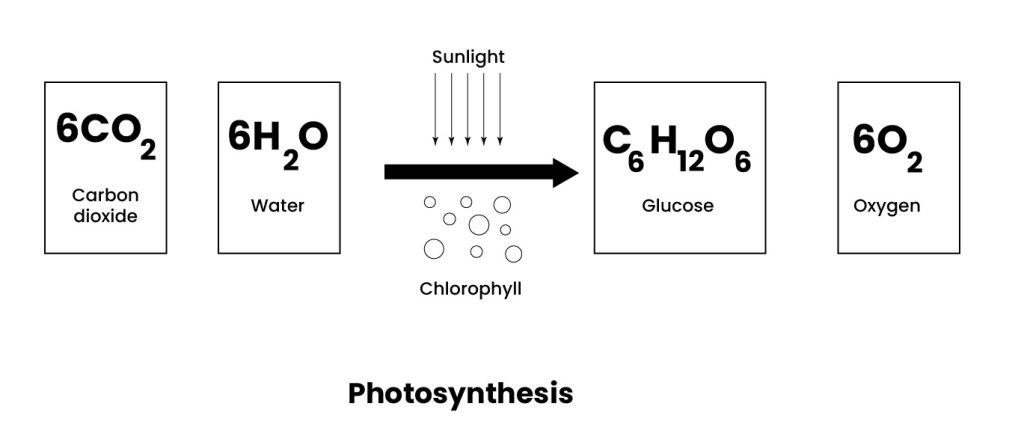
(B) Briefly explain the Nitrogen Cycle in nature.
Define Nitrogen Cycle:
The nitrogen cycle is a chain of continuous processes through which nitrogen circulates within various components of the environment, including the atmosphere, soil, water, plants, animals, and bacteria. It plays a significant role in sustaining life on Earth.
Steps of Nitrogen Cycle:
The key steps in the nitrogen cycle can be categorized as follows:
- Nitrogen Fixation:
The first step in the nitrogen cycle is the conversion of nitrogen gas (N2) into inorganic nitrogen compounds. The majority of this conversion, about 90%, is carried out by specific bacteria and blue-green algae. A smaller amount of free nitrogen is fixed through non-biological processes like lightning and ultraviolet radiation.
- Nitrogen Assimilation:
Nitrates and ammonia produced during nitrogen fixation are absorbed and utilized by algae and higher plants to create specific tissue compounds. Animals consume these plants and algae, incorporating nitrogen into their own body compounds.
- Ammonification:
After the death of living organisms, including plants and animals, microorganisms facilitate the decomposition process known as ammonification. This process results in the production of ammonia (NH3) and ammonium (NH4+). Depending on soil conditions, ammonia can either leave the soil or transform into various nitrogen compounds.
- Nitrification:
Nitrifying bacteria are responsible for converting soil ammonia into nitrates (NO3−). These nitrates can be taken up by plants and integrated into their own tissues.
- Denitrification:
In water-logged anaerobic soils, denitrifying bacteria play a crucial role in metabolizing nitrates. This action reduces soil nitrate levels and releases free atmospheric nitrogen back into the environment.
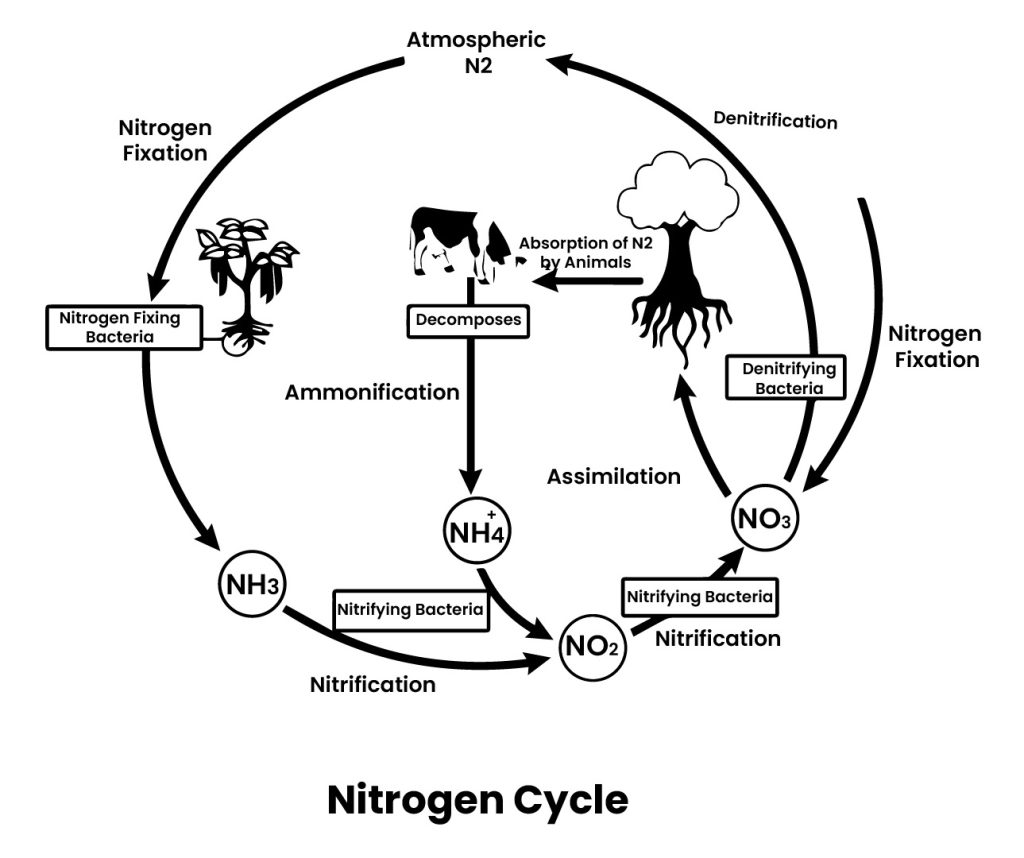
Question No. 8
Question Breakdown:
In both parts of this question, the examiner demands your knowledge regarding DNA, RNA, and protein. In the first part, he has asked you to explain differences among the three, and in the second part, he has asked you to clarify the interrelationship among them. So, first draw a table of differences with diagrams of all three – i.e., structures, and then explain the phenomenon through which they are linked. Don’t forget to draw an explanatory diagram here too.
Answer
(A) Differentiate between the following:
1- Deoxyribonucleic Acids (DNA)
2- Messenger Ribonucleic Acids (mRNA)
3- Proteins
| Characteristics | DNA | mRNA | Proteins |
| Definition | DNA is molecule containing all essential information required for cell growth, division, and function. | mRNA is a subtype of RNA that is involved in proteins synthesis and is created by the process called transcription | Proteins are large, complex nitrogenous organic compounds that are essential constituents of living cells. |
| Building blocks | DeoxyRibonucleotides | Ribonucleotides | Amino acids |
| Composition | Made up of four types of Deoxy ribonucleotides: Adenine , Guanine, Cytosine, Thymine | Made up of four types of Ribonucleotides: Adenine, Guanine, Cytosine, Uracil. | Made up of 20 different amino acids. |
| Location | DNA is located inside the nucleus in eukaryotes and in cytoplasm in prokaryotes. | mRNA is formed inside the nucleus and then transported into the cytoplasm in eukaryotes.. | Protein is found throughout the body. In muscle, bone, skin ,hair ,and virtually every other body part or tissue. |
| Function | DNA mainly stores the genetic information to make proteins in a cell. | mRNA carries information about the sequence of amino acids for forming protein. It also brings the information from the nucleus to the ribosome to synthesize protein. | Proteins are important in structure, function and regulation of the body’s tissues and organs. It is the major source of energy. |
| Structure | Double helix structure | Single-stranded | A complex molecule made up of carbon-hydrogen, oxygen, nitrogen |

(B) Explain how DNA, mRNA, and Proteins are interrelated to each other.
DNA, mRNA, and protein are closely related to each other. DNA contains all the information required for encoding proteins. However, it does not produce proteins directly. The phenomenon is called Central Dogma that happens through following steps
- First, mRNA is created from DNA, containing the instructions for the creation of proteins. This process is called transcription.
- Second, mRNA transports these instructions from DNA out of the nucleus to the cytoplasm, where the mRNA attaches to the cell’s ribosome. These instructions are present in the form of codes called codons.
- Third, the mRNA gives instruction to tRNA to string together specific amino acids at the mRNA-ribosome structure. This process is called translation. In this way, a particular sequence of amino acids forms that produce a protein with a specific function.

Question No. 9
Question Breakdown:
In both parts of this question, the examiner demands your knowledge regarding balanced diet. In the first part, he has asked you to explain the meaning of balanced diet, and in the second part, he has asked you to clarify functions of certain provided nutrients. So, in the first part, define balanced diet, draw a piechart of nutrients distribution in the balanced diet, and explain its component. Likewise , while answering second part, you can draw a table with two columns, one column with the names and another with its functions
Answer
(A) Explain what is meant by a balanced diet
Define Balanced Diet:
A diet that contains all the essential nutrients of food in a proper proportion is called a balanced diet. Balanced diet is the name of meeting the body’s nutritional needs while managing calorie intake effectively. It involves obtaining nutrients from five major food groups, called the components of Balanced diet, focusing on vegetables and fruits. The remaining portion should include proteins and grains. A small serving of low-fat dairy is also recommended. This approach ensures the right proportions of essential nutrients required for human body, thus, promoting overall health and well-being.
Percentage Formula of Balanced Diet

Components of Balanced Diet
| Carbohydrates | The main source of energy for the human body |
| Proteins | Essential to the growth and repair of body tissues and muscles |
| Fats | Source of energy and important to fat-soluble vitamins. |
| Vitamins | Water and fat-soluble vitamins play important roles in many chemical processes in the body |
| Water | A most significant requirement of the human body that is essential for its normal functioning |
(B) Give the major function of the following micronutrients: Vitamin A, Vitamin C, Iron, Calcium, Iodine
| Micronutrients | Functions |
| Vitamin A | Imperative for Growth and body repair, keeps the skin smooth, and is essential for vision Lack of this vitamin may results in night blindness and dryness of skin. |
| Vitamin C | Essential for protection of bones and healthy teeth and gums Deficiency Can lead to scurvy |
| Iron | Serves as a carrier of oxygen from the lungs to the tissues by RBCs (red blood cells), thus, helping in blood production blood production. Deficiency is one of the very common causes of iron deficiency anaemia in pregnancy |
| Calcium | In human body, calcium maintains the strength of bones and teeth. It also plays an important role in blood clotting, regulating normal heart rhythms and nerve functions, and helping muscles to contract. |
| Iodine | Changes food into energy. It also involves normal thyroid function and for the production of thyroid hormones as well. Iodine deficiency can lead to thyroid disease, permanent brain damage, and intellectual disability in babies. |
CSS Solved Past Papers’ Essays
Looking for the last ten years of CSS and PMS Solved Essays and want to know how Sir Kazim’s students write and score the highest marks in the essays’ papers? Then, click on the CSS Solved Essays to start reading them.
CSS Solved Essays

CSS Solved General Science & Ability Past Papers
| 1- | CSS Solved General Science And Ability Past Paper 2023 |
| 2- | CSS Solved General Science And Ability Past Paper 2022 |
| 3- | CSS Solved General Science And Ability Past Paper 2021 |
| 4- | CSS Solved General Science And Ability Past Paper 2020 |
| 5- | CSS Solved General Science And Ability Past Paper 2019 |
| 6- | CSS Solved General Science And Ability Past Paper 2018 |
| 7- | CSS Solved General Science And Ability Past Paper 2017 |
| 8- | CSS Solved General Science And Ability Past Paper 2016 |
| 9- | CSS Solved General Science And Ability Past Paper 2015 |
| 10- | CSS Solved General Science And Ability Past Paper 2014 |
| 11- | CSS Solved General Science And Ability Past Paper 2013 |
| 12- | CSS Solved General Science And Ability Past Paper 2012 |
| 13- | CSS Solved General Science And Ability Past Paper 2011 |
| 14- | CSS Solved General Science And Ability Past Paper 2010 |
| 15- | CSS Solved General Science And Ability Past Paper 2009 |
| 16 | CSS Solved General Science And Ability Past Paper 2008 |
| 17- | CSS Solved General Science And Ability Past Paper 2007 |
| 18- | CSS Solved General Science And Ability Past Paper 2006 |
| 19- | CSS Solved General Science And Ability Past Paper 2005 |
| 20- | CSS Solved General Science And Ability Past Paper 2004 |
| 21- | CSS Solved General Science And Ability Past Paper 2003 |
| 22- | CSS Solved General Science And Ability Past Paper 2002 |
| 23- | CSS Solved General Science And Ability Past Paper 2001 |
| 24- | CSS Solved General Science And Ability Past Paper 2000 |
Articles Might Interest You!
The following are some of the most important articles for CSS and PMS aspirants. Click on any to start reading.












